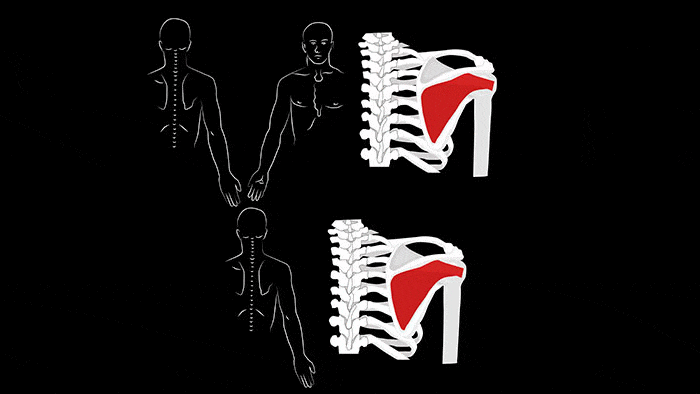In this post we will take a closer look the trigger points which can cause pain in the shoulder joint, along the anterolateral surface of the arm, along the vertebral edge of the blade and at the base of the neck. Let’s take a look at the exercises using which you can eliminate pain at home by yourself.

Anatomy of the infraspinatus muscle
The infraspinatus muscle starts from the entire surface of the infraspinous fossa, leaving the lateral border and the inferior angle of the scapula loose.
The other end of the infraspinatus muscle is attached to the greater tubercle of the humerus by a short tendon.
The initial part of the infraspinatus muscle is covered by the trapezius muscle, the area of attachment to the shoulder is covered by the deltoid muscle, the lower part is covered by the teres major muscle and the broadest muscle of the back.

Functions of the infraspinatus muscle
The infraspinatus muscle performs external rotation of the shoulder (together with the posterior part of the deltoid muscle and the small round muscle).
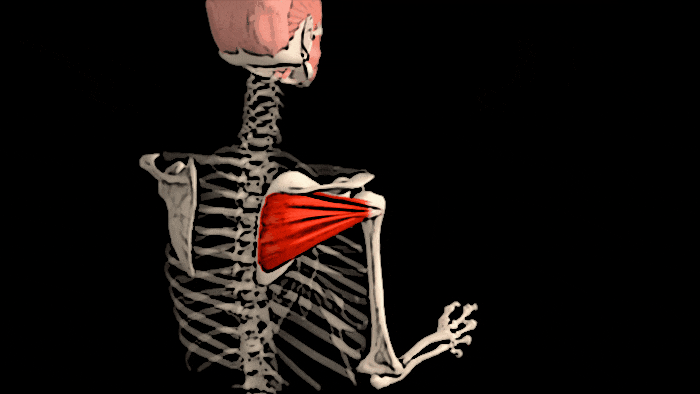
It’s involved in shoulder abduction with external rotation
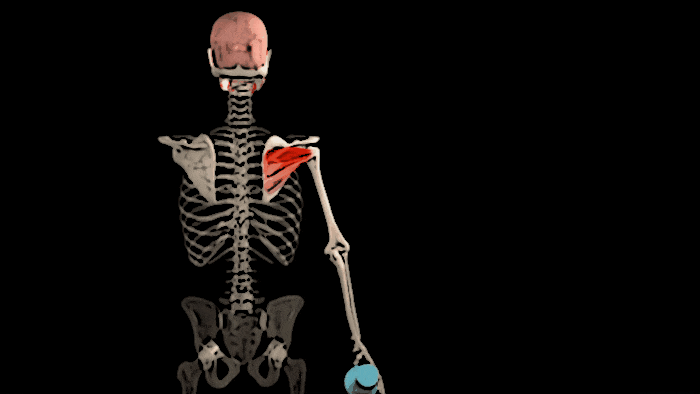
and involved in the horizontal shoulder abduction.
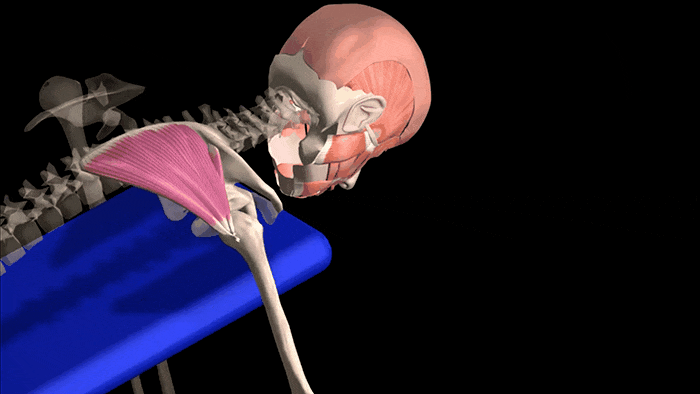
The Infraspinatus muscle stabilizes the head of the humerus in the glenoid cavity of scapula during arm movement and is part of the rotational cuff of the shoulder.
Trigger points of the infraspinatus muscle
Trigger points of the infraspinatus muscle cause deep pain along the front of the shoulder, and in the shoulder joint that goes down the anterolateral surface of the arm, extending to the Lateral (radial) side of the palm and sometimes extending to the fingers of the hand or to the suboccipital area.
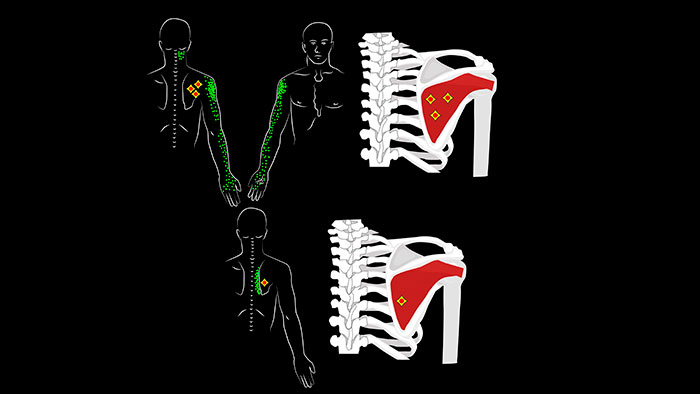
A trigger point located in the tendon-muscle junction area near the vertebral edge of the scapula causes soreness in this area, similar to reflected pain coming from the trigger points of the rhomboid muscles
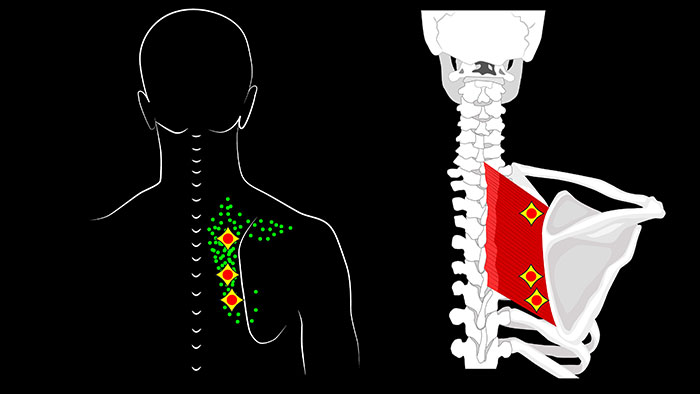
and the fourth trigger point located in the middle part of the trapezius muscle.
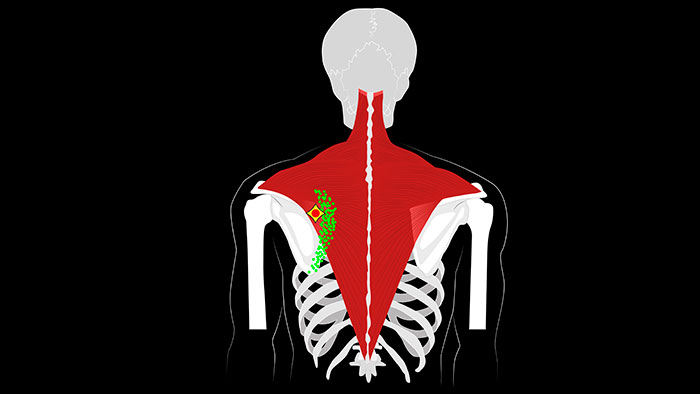
If the infraspinatus muscle is affected by the trigger points, We can observe complaints of not only the above-described pain, but also of inability to reach a back pocket of the pants, to button up a bra, skirt or dress. While combing hair, shaving or brushing teeth – a sharp pain can occur in the shoulder joint.
If a person is into sports, such as volleyball or tennis, then in addition to the pain in the shoulder, you may hit the ball much weaker than usual. In some cases the pain doesn’t allow you to lie not only on your affected side, but also on your back, because the chest activates the trigger points located in the infraspinatus muscle by its own weight.
If a person lies on the healthy side and the arm is hanging down during sleep, prolonged stretching of the problematic infraspinatus muscle can also increase pain and discomfort, preventing proper rest and recovery.
Activation of trigger points in the infraspinatus muscle usually occurs as a result of acute stress or numerous stressful loads, for example, while leaning on a ski pole while skiing. To determine the lesion of the supraspinatus muscle, try placing your hand behind your back and touching the opposite scapula with it. Normally, the fingertips should reach the spine of the shoulder blade or go even further.
If the range of flexibility is significantly limited and a person can bring the hand only to the level of the hip joint,
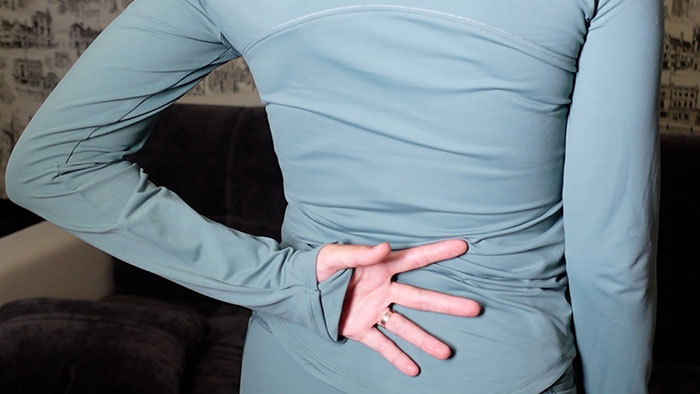
it is possible to conclude that the muscle fibers of the infraspinatus muscles are sharply shortened and have trigger points, which can be easily detected by having mechanical effect on the places of their typical location, for example with the help of a massage ball against the wall.
Infraspinatus muscle release
At home, you can reduce the intensity of pain or eliminate it completely by having strong impact on the trigger points, followed by stretching the muscle. While rolling the body on a large massage roller pay close attention to the area of the scapula and roll both right and left sides of the chest.
Then take a small 3-inched massage ball, walk up to the wall, find your scapula, locate the spine of the scapula and the area of the infraspinous fossa and roll the infraspinatus muscle.

When you find the densified areas and the areas of increased soreness, then stop and apply pressure on them for 1-2 minutes. After that work out the opposite muscle. You can have a more intensive impact on the problem areas of the muscle by doing it on the floor, under the weight of your own body
Infraspinatus muscle stretch
Since the main functions of the infraspinatus muscle are external rotation of the shoulder, shoulder abduction with external rotation and horizontal shoulder abduction, it can be stretched with exercises that perform internal rotation of the shoulder with shoulder adduction or horizontal shoulder adduction.
In my yoga training programs, you could see an exercise where the hands are placed in front of your rib cage, the hands are pressed to the floor and then pressure is exerted on the hands with the weight of the body. This exercise, which is called the dragonfly pose, helps to perform a horizontal shoulder adduction with internal rotation and stretch the infraspinatus muscle.
The following exercise can also be used to stretch the infraspinatus muscle. Sit on the floor, bend your knees, and place your feet hip-width apart. Then place your hands with the backs of your hands on the sides of your body, preventing them from slipping to the navel,
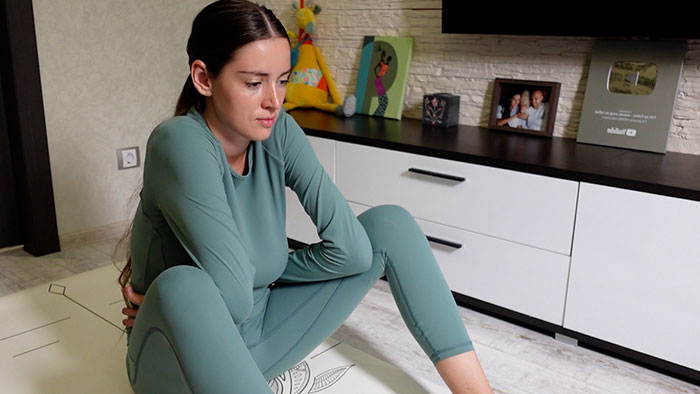
put your elbows between your legs and apply very gentle pressure on your hands with your feet, relaxing and stretching the muscles more and more with each exhalation.
Another very effective exercise for stretching the infraspinatus muscle is the handgrip behind the back. It can be done both standing and sitting on your heels, or, for example, as it is implemented in my yoga workouts, sitting in virasana. One arm is pulled down from behind the head and the other hand is pulled up from the lower back.
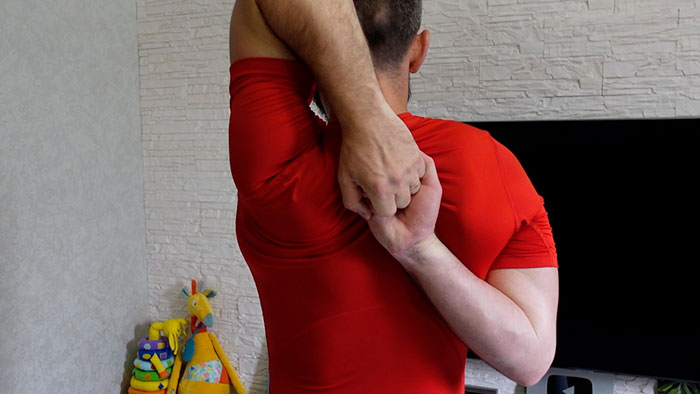
Try to pull the fingers as close as possible to each other, ideally with one hand gripping the other in a wrist lock. If you have a distinct mobility limitation and can only put your hand behind your back, for example, at the level of the lower back, then use a belt or a yoga loop or even a sock. Grab the ends with your hands and try to get them a little closer together.
The fixation phase of all the above exercises is 1-2 minutes against the background of deep and calm breathing through the nose. If you do these exercises not in the yoga complex, which is more preferable, but separately, then the stretching itself can be done under a stream of warm shower, and after the stretching you can additionally put a hot-water bottle on the scapula area.
In addition to regular therapeutic exercises, you should pay special attention to your sleeping position. While lying on your healthy side, you should put an extra pillow under your arm, which will limit the overextension of the infraspinatus muscle.

If you have a problematic infraspinatus muscle, also avoid prolonged static or regularly repeated dynamic positions when arms raised above the head, such as abduction of the shoulder, e.g., while painting ceilings or playing tennis, and also prolonged fixation of the shoulder in an external rotation positions. e.g. while driving a truck with a large steering wheel for many hours or while working at a computer with the mouse far to the side.
I also highly recommend you to watch a video about the supraspinatus muscle, which is very often affected by trigger points in the place with the infraspinatus muscle.

